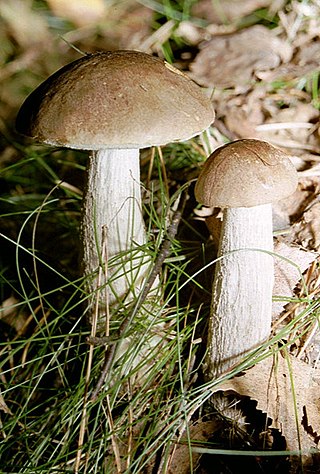
Leccinum scabrum, commonly known as the rough-stemmed bolete, scaber stalk, and birch bolete, is an edible mushroom in the family Boletaceae, and was formerly classified as Boletus scaber. The birch bolete is widespread in Europe, in the Himalayas in Asia, and elsewhere in the Northern Hemisphere, occurring only in mycorrhizal association with birch trees. It fruits from June to October. This mushroom is also becoming increasingly common in Australia and New Zealand where it is likely introduced.

Leccinum is a genus of fungi in the family Boletaceae. It was the name given first to a series of fungi within the genus Boletus, then erected as a new genus last century. Their main distinguishing feature is the small, rigid projections (scabers) that give a rough texture to their stalks. The genus name was coined from the Italian Leccino, for a type of rough-stemmed bolete. The genus has a widespread distribution, especially in north temperate regions, and contains about 75 species.

Caloboletus calopus, commonly known as the bitter bolete, bitter beech bolete or scarlet-stemmed bolete, is a fungus of the bolete family, found in Asia, Northern Europe and North America. Appearing in coniferous and deciduous woodland in summer and autumn, the stout fruit bodies are attractively coloured, with a beige to olive cap up to 15 cm (6 in) across, yellow pores, and a reddish stipe up to 15 cm (6 in) long and 5 cm (2 in) wide. The pale yellow flesh stains blue when broken or bruised.

Boletus aereus, commonly known as the dark cep, bronze bolete, or queen bolete, is a highly prized and much sought-after edible mushroom in the family Boletaceae. The bolete is widely consumed in Spain, France, Italy, Greece, and generally throughout the Mediterranean. Described in 1789 by French mycologist Pierre Bulliard, it is closely related to several other European boletes, including B. reticulatus, B. pinophilus, and the popular B. edulis. Some populations in North Africa have in the past been classified as a separate species, B. mamorensis, but have been shown to be phylogenetically conspecific to B. aereus and this taxon is now regarded as a synonym.

Chalciporus piperatus, commonly known as the peppery bolete, is a small pored mushroom of the family Boletaceae found in mixed woodland in Europe and North America. It has been recorded under introduced trees in Brazil, and has become naturalised in Tasmania and spread under native Nothofagus cunninghamii trees. A small bolete, the fruit body has a 1.6–9 cm orange-fawn cap with cinnamon to brown pores underneath, and a 4–9.5 cm high by 0.6–1.2 cm thick stipe. The flesh has a very peppery taste. The rare variety hypochryseus, found only in Europe, has yellow pores and tubes.
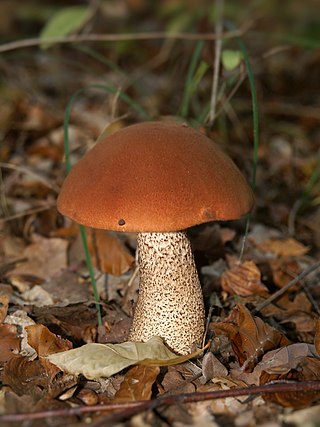
Leccinum aurantiacum is a species of fungus in the genus Leccinum found in forests of Eurasia and North America. It has a large, characteristically red-capped fruiting body. In North America, it is sometimes referred to by the common name red-capped scaber stalk. Some uncertainties exist regarding the taxonomic classification of this species in Europe and North America. It is considered edible, but must be cooked thoroughly.

Xerocomus subtomentosus, commonly known as suede bolete, brown and yellow bolete , boring brown bolete or yellow-cracked bolete, is a species of bolete fungus in the family Boletaceae. The fungus was initially described by Carl Linnaeus in 1753 and known for many years as Boletus subtomentosus. It is edible, though not as highly regarded as other bolete mushrooms.

Leccinum manzanitae is an edible species of bolete fungus in the family Boletaceae. Described as new to science in 1971, it is commonly known as the manzanita bolete for its usual mycorrhizal association with manzanita trees. Its fruit bodies (mushrooms) have sticky reddish to brown caps up to 20 cm (8 in), and its stipes are up to 16 cm (6.3 in) long and 3.5 cm (1.4 in) thick. They have a whitish background color punctuated with small black scales known as scabers. Found only in the Pacific Northwest region of the United States and Canada, it is the most common Leccinum species in California. The mushroom is edible, although opinions vary as to its quality. L. manzanitae can be usually distinguished from other similar bolete mushrooms by its large size, reddish cap, dark scabers on a whitish stipe, and association with manzanita and madrone.
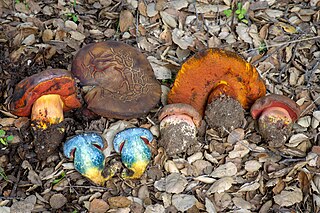
Suillellus amygdalinus is a fungus of the bolete family found in western North America. The fruit bodies, or mushrooms, are characterized by their thick, red to brown caps, red pores, and the strong bluing reaction observed when the mushroom tissue is injured or cut. The cap can reach diameters of up to 12 cm (4.7 in) and the stipe 9 cm (3.5 in) long by 3 cm (1.2 in) thick at maturity. This mushroom has been found in manzanita and madrone woodlands of central California north to southern Oregon. Although the edibility of the mushroom is not known with certainty, it may be poisonous, and is not recommended for consumption. Other similar red-pored, bluing boletes from North America, including Rubroboletus eastwoodiae, Boletus luridiformis, and B. subvelutipes, can be distinguished from S. amygdalinus either by the color of the cap, the degree of reticulation on the stipe, or by location.

Leccinum arenicola is a species of bolete mushroom in the family Boletaceae. Described in 1979, the fruit bodies (mushrooms) grow in sand dunes from New Brunswick south to Cape Cod.

Agrocybe putaminum, commonly known as the mulch fieldcap, is a species of agaric fungus in the family Strophariaceae in the Agrocybe sororia complex. Described as new to science in 1913, it is found in Asia, Australia, Europe, and western North America, where it grows in parks, gardens, and roadsides in woodchip mulch. Fruitbodies of the fungus have a dull brownish-orange cap with a matte texture, a grooved stipe, and a bitter, mealy taste.

Harrya chromapes, commonly known as the yellowfoot bolete or the chrome-footed bolete, is a species of bolete fungus in the family Boletaceae. The bolete is found in eastern North America, Costa Rica, and eastern Asia, where it grows on the ground, in a mycorrhizal association with deciduous and coniferous trees. Fruit bodies have smooth, rose-pink caps that are initially convex before flattening out. The pores on the cap undersurface are white, aging to a pale pink as the spores mature. The thick stipe has fine pink or reddish dots (scabers), and is white to pinkish but with a bright yellow base. The mushrooms are edible but are popular with insects, and so they are often infested with maggots.

Leccinum cyaneobasileucum is a species of bolete fungus in the family Boletaceae. Originally found growing under silver birch, it was described as new to science in 1991. The fungus produces fruit bodies with caps measuring 5–15 cm (2–6 in) wide that range in colour from hazel, to reddish-yellow, to walnut brown. The white to grey stipe measures 7–20 cm (3–8 in) long by 0.8–2 cm (0.3–0.8 in) thick and is covered with brownish scales. In deposit the spores are walnut brown; microscopically, they are somewhat spindle shaped and measure 14–18 by 5–6 μm. L. cyaneobasileucum grows under birch, usually in moss. The mushroom is edible but not particularly tasty.
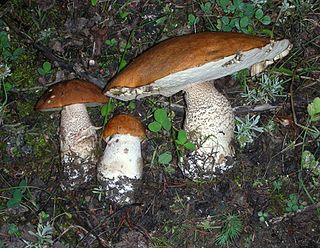
Leccinum insigne, commonly known as the aspen bolete or the aspen scaber stalk, is a species of bolete fungus in the family Boletaceae. Described as new to science in 1966, it is found in North America, where its range extends from eastern Canada south to New Jersey and west to the northern Rocky Mountains. It is a good edible mushroom, but there have been documented cases of adverse reactions; these range from headaches to gastrointestinal distress, which may or may not be attributed to food sensitivities alone. The specific epithet insigne means "distinctive or outstanding".
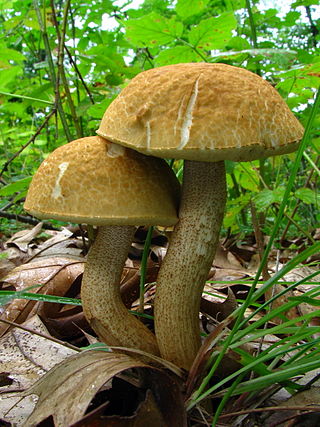
Leccinellum rugosiceps, commonly known as the wrinkled Leccinum, is a species of bolete fungus. It is found in Asia, North America, Central America, and South America, where it grows in an ectomycorrhizal association with oak. Fruitbodies have convex, yellowish caps up to 15 cm (5.9 in) in diameter. In age, the cap surface becomes wrinkled, often revealing white cracks. The stipe is up to 10 cm (3.9 in) long and 3 cm (1.2 in) wide, with brown scabers on an underlying yellowish surface. It has firm flesh that stains initially pinkish to reddish and then to grayish or blackish when injured. The pore surface on the cap underside is yellowish. Fruitbodies are edible, although opinions vary as to their desirability.
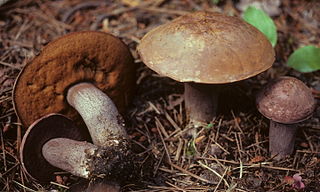
Sutorius eximius, commonly known as the lilac-brown bolete, is a species of fungus in the family Boletaceae. This bolete produces fruit bodies that are dark purple to chocolate brown in color with a smooth cap, a finely scaly stipe, and a reddish-brown spore print. The tiny pores on the cap underside are chocolate to violet brown. It is widely distributed, having been recorded on North America, South America, and Asia, where it grows in a mycorrhizal relationship with both coniferous and deciduous trees.

Hemileccinum impolitum is a basidiomycete fungus of the family Boletaceae, native to Europe. It is commonly referred to as the iodine bolete, because its fruit bodies tend to emit an iodine-like odour when cut, more detectable in the stem base or overripe specimens.

Imleria badia, commonly known as the bay bolete, is an edible, pored mushroom found in Eurasia and North America, where it grows in coniferous or mixed woods on the ground or on decaying tree stumps, sometimes in prolific numbers. Both the common and scientific names refer to the bay- or chestnut-coloured cap, which is almost spherical in young specimens before broadening and flattening out to a diameter up to 15 cm (6 in). On the cap underside are small yellowish pores that turn dull blue-grey when bruised. The smooth, cylindrical stipe, measuring 4–9 cm long by 1–2 cm thick, is coloured like the cap, but paler. Some varieties have been described from eastern North America, differing from the main type in both macroscopic and microscopic morphology.
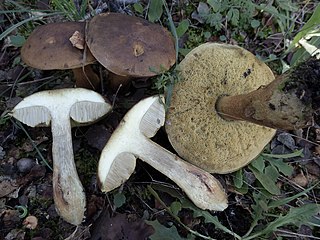
Leccinellum lepidum is a species of bolete in the family Boletaceae. Originally described as Boletus lepidus in 1965, the fungus has gone through controversial taxonomic treatments over the years and was subsequently transferred to genus Krombholziella in 1985, to genus Leccinum in 1990, and to genus Leccinellum in 2003. It is the sister-species of Leccinellum corsicum, with which it had been erroneously synonymised by some authors in the past.





















